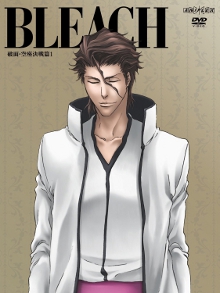
The Agent of the Shinigami arc is the first season of the Bleach anime series. The episodes are directed by Noriyuki Abe, and produced by TV Tokyo, Dentsu and Studio Pierrot. In the English release by Viz Media, its title is translated as The Substitute. The episodes are based on Tite Kubo's Bleach manga series, spanning twenty episodes. The episodes' plot covers the adventures of Ichigo Kurosaki after becoming a Soul Reaper and assuming the duties of Soul Reaper Rukia Kuchiki.

The Soul Society: The Sneak Entry arc is the second season of the Bleach anime series, containing 21 episodes. The episodes are directed by Noriyuki Abe, and produced by TV Tokyo, Dentsu and Studio Pierrot. In the English release by Viz Media, the title is translated as The Entry. The episodes are based on Tite Kubo's Bleach manga series. The episodes' plot centers on Ichigo Kurosaki and his friends' journey to the Soul Society in order to save Soul Reaper Rukia Kuchiki from her impending execution.

The Soul Society: The Rescue arc is the third season of the Bleach anime series. In the English adaptation of the anime released by Viz Media, the title of the season is translated as The Rescue. The episodes are directed by Noriyuki Abe, and produced by TV Tokyo, Dentsu and Studio Pierrot. The episodes are based on Tite Kubo's Bleach manga series over twenty-two episodes. The episodes' plot centers on Ichigo Kurosaki's and his friends' efforts to save Soul Reaper Rukia Kuchiki from execution by her superiors in the Soul Society.

The fifth season of the Bleach anime series is named the Bount Assault on Soul Society arc. In the English adaptation of the anime released by Viz Media, the title of the season is translated as The Assault. The episodes are directed by Noriyuki Abe, and produced by TV Tokyo, Dentsu and Studio Pierrot. Like the previous season, it does not adapt part of Tite Kubo's Bleach manga. Instead, it features a completely original, self-contained story arc focusing on the invasion of the Soul Society, the home of the Soul Reapers, by the Bount, a race of humans that consume human souls to extend their lives.

The fourth season of the Bleach anime series was directed by Noriyuki Abe and produced by Studio Pierrot. Like the rest of the series, it follows the adventures of Ichigo Kurosaki, but instead of adapting Tite Kubo's Bleach manga, it features an original, self-contained story arc. The twenty-eight episodes form the Bount arc, which focuses on the introduction of the Bount, a race of humans that consume human souls to extend their lives, and their conflicts with Ichigo Kurosaki and his allies.

The seventh season of the Bleach anime series is named the Arrancar: The Hueco Mundo Sneak Entry arc. In the English adaptation of the anime released by Viz Media, the title of the season is translated as The Hueco Mundo. The episodes are directed by Noriyuki Abe, and produced by TV Tokyo, Dentsu and Studio Pierrot. The twenty episodes featured in the season are based on Tite Kubo's Bleach manga series. The season follows Ichigo Kurosaki's journey to Hueco Mundo to rescue Orihime Inoue, who was kidnapped by the arrancar under the command of former Soul Reaper captain Sōsuke Aizen. Although episodes focused on the character Ashido Kanō were not featured in the manga due to timing issues, Kubo still helped the anime staff to show them in the anime.

The ninth season of the Bleach anime series is named The New Captain Shūsuke Amagai arc. The series is based on Tite Kubo's Bleach manga series. The episodes are directed by Noriyuki Abe, and produced by TV Tokyo, Dentsu and Studio Pierrot. The season focuses on the introduction of a new Soul Reaper captain, Shūsuke Amagai, and the mystery surrounding the Kasumiōji clan, one of the families that constitute the nobility of Soul Society.
Kelun is a Japanese rock band signed by Sony Music Entertainment Japan.

The eighth season of the Bleach anime series is named the Arrancar: The Fierce Fight arc. The episodes are directed by Noriyuki Abe, and produced by TV Tokyo, Dentsu and Studio Pierrot. Based on Tite Kubo's Bleach manga series, the episodes' plot centers on Ichigo Kurosaki's and his friends' battle against the Espada, the strongest members of former Soul Reaper captain Sōsuke Aizen's army, to save Orihime Inoue.

The episodes of the twelfth season of the Bleach anime series, released on DVD as the Arrancar: Decisive Battle of Karakura arc. They are directed by Noriyuki Abe, and produced by TV Tokyo, Dentsu and Studio Pierrot. The 17-episode season is based on Tite Kubo's Bleach manga series. The plot continues to show the fight between the Soul Reapers against Sōsuke Aizen's army of arrancars, with the former defending Karakura Town, and the latter planning to use Karakura Town to invade and destroy Soul Society. The season moves on to auto-conclusive stories beginning with episode 227.

The sixteenth season of the Bleach anime series is known as the Lost Agent arc. It is directed by Noriyuki Abe, and produced by TV Tokyo, Dentsu and Studio Pierrot. Based on Tite Kubo's Bleach manga series, the season is set seventeen months after Ichigo Kurosaki lost his Soul Reaper powers and meets a man known as Kūgo Ginjō who proposes him to recover them.











